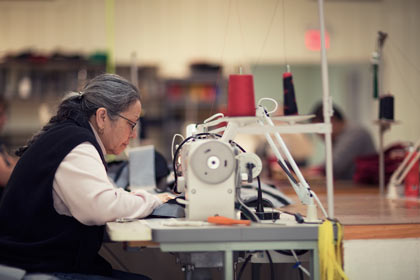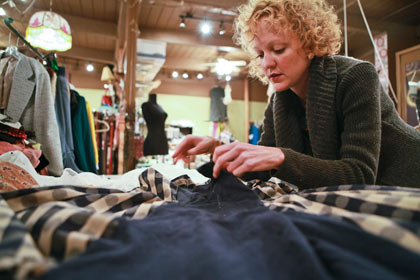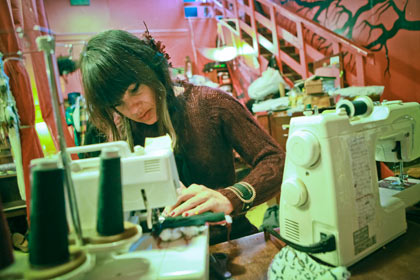EUGENE, Ore., April 2015: The fifth annual Eugene Fashion Week is only days away and the Eugene Garment House is a beehive of activity. Frenzied designers dart around the open space on the third floor of the Woolworth Building overlooking Willamette Street, colorful swatches of fabric tucked under their arms and pincushions wrapped around their wrists. Apprentices hurriedly reorganize racks of fluttering paper patterns and sample garments while production sewers put the finishing touches on a pair of couture overalls and a hemp wedding gown. At one station, a team of interns dyes a line of jersey dresses. In the corner, set up as a mock catwalk, local designer Mitra Chester is fitting a local model in an edgy, tailored three-piece skirt suit made out of repurposed, studded leather. “Where are my recycled couch-brocade fabric cigarette pants?” one designer yells above the din.
This hasn’t happened. Yet. No one is manufacturing couture overalls or hemp wedding dresses, or losing it over a cigarette pant in some hip loft space downtown. The Woolworth Building doesn’t host and has no plans to host any kind of House d’Eugène. There is no Eugene Garment House — but there could and should be one. As Robert Kennedy said, “I dream of things that never were, and ask, ‘Why not?’”
Now, sir, I’m no Robert Kennedy, but perhaps it time for Eugene to ask “Why not?”
A garment house, or a production factory, is where designers can go to have their designs professionally produced, allowing for much larger batches of couture overalls, for example, than an individual could possibly produce. They are equipped with industrial machinery, such as sergers (for hems and seams) and sewing machines that can easily send needles through inches of leather — machinery that is typically too costly for an indie designer to invest in alone — and depending on the factory, they provide services such as drafting, size grading, sample construction and design consultation.
 |
|
Employee at T&J sewing. Photo by Rob Sydor • robsydor.com
|
 |
|
Laura Lee Laroux at her shop and studio, the Redoux Parlour.
Photo by Todd Cooper. |
According to many professionals in the local fashion industry, Eugene needs a garment production factory like Portland needed one in 2008 when clothing designer and entrepreneur Britt Howard opened the Portland Garment Factory to help local indie designers produce their smaller lines — lines that are too small to be profitable for larger domestic and overseas clothing manufacturers to take on. The Portland Garment Factory has been a wild success both critically and financially, receiving accolades locally (The Oregonian, Portland Mercury, Portland Monthly) and nationally (The New York Times) and now has over 45 clients.
Local designers and business owners like Mitra Chester of Deluxe, Laura Lee Laroux of Redoux Parlour, Loralee Harding of Circle Creations and James Breech of Trust Hemp are convinced that Eugene is ready. They don’t just foresee potential for demand to make a production house profitable — the demand is already here, and they can no longer keep up with it. A factory where local designs are produced would not only be a boon for designers but an investment in the city’s economic and cultural future, as well as a method of creating jobs and keeping labor conditions humane, especially after the fatal factory fires in Bangladesh in November. Before Eugene can become the next Milan (or Portland), however, an airtight business plan is needed, and, of course, financing. But if Eugeneans want their beer brewed around the block, their coffee roasted where they can smell it and their food harvested within biking distance, then why not their clothes?
A Passion (and Demand) for Fashion
“If I could, I would be producing my wallet cuffs like crazy,” Chester says, while stirring a cup of coffee at Sweet Life Patisserie. Chester has a popular line of wrist cuffs, made of repurposed materials, that also function as wallets — in a nutshell, what Billie Joe Armstrong would wear to be both cool and practical. “I’m restricted with the machinery that I use to produce this stuff and it slows down the process for me.”
“Yeah, I’m in the same boat,” Laroux says, nodding. Her clothing at the Redoux Parlour, like shirtdresses and overalls, sells out faster than she can produce it. Laroux says that in the months leading up to Eugene Fashion Week or Oregon Country Fair, there are never enough hands or machines to manufacture her designs.
“There’s a lot of people in the DIY fashion movement in Eugene that we know that basically are doing this as a side project. It’s their art; it’s their passion, but they have to hold down regular jobs to makes ends meet. If there were resources like a fashion house, a production house, available to them, they could actually take it to the next step,” Chester says. “They could start incorporating their art into a business. A lot of us who are spread so thin as designers, we’re kind of at a stagnating state with the lack of this kind of resource available to us.”
Chester and Laroux say the typical process for taking a design from idea to fruition is to make a prototype, tweak it, make another prototype, tweak it and so on until they have a product that both functions and looks the way they want it. For help with prototypes, some designers enlist contracted sewers, many of whom are in Salem, Portland or further afield.
“If you’re having to run all the way up to Portland every time to look at something …” Laroux says.
“It’s not sustainable,” Chester adds. They both shake their heads.
Harding, founder of Circle Creations and co-owner of the new Trillium boutique in south Eugene, is one of those designers. “I’ve been searching for more [sewers]. I have about three new designs right now that aren’t done for the holidays, so I’m definitely behind on that,” says Harding, who uses Cascade Commercial Cutting and Sewing in Salem for some of her designs. “There’s nothing large scale in the area. It’s definitely not convenient.” Lee continues, “We kind of have a special niche in Eugene. We’re kind of known along the West Coast that we have a lot of designers and really good clothing companies. So I think it would be a good fit to have a production facility here.”
Two years ago, Chester, Laroux, Harding and over a dozen other local garment industry professionals began meeting with Leah Murray, a program coordinator at eDev, a local nonprofit organization that helps micro entrepreneurs reach their business goals through classes, counseling and small grants. Chester, Laroux, Harding and Breech have all used eDev to grow their businesses. Murray says that when Sew Unique, a former sewing outfit in Eugene, closed “it left a major hole in the community.” So the group would discuss their business needs and a garment production house would always be at the top of the list. Murray advised them on possible avenues of funding — microloans, urban renewal funds from the city of Eugene and even Kickstarter. “They have roots here,” says Murray of the designers. “Why should they have to leave?”
Breech, Trust Hemp founder and the other co-owner of Trillium, was also at those meetings. “This idea keeps coming back. It might be a critical mass moment,” Breech says. The lack of access to local, reliable production for local designers has been a “major roadblock to success.”
The Springfield Model
In late November, Mitra Chester and Laura Lee Laroux tour T&J Sewing in Springfield, a small production house that produces canvas tote and bike bags for companies like Archival Clothing. The windowless concrete building sits on Main Street, a complete mystery to the outside world. The only sign of occupancy is “T&J Sewing” hand-scrawled on the front door. Inside, is a cacophony of production: the buzz of straight-stitch and cover-stitch sewing machines, sergers (for hemming and seaming), grommet and snap machines and T&J’s 10 employees fill the spotless 7,600-sq.-ft. space with activity. Spools of colorful thread line white shelves, sample bags dangle from hooks on the walls and a rack full of paper patterns flutter whenever someone walks by. After a walk-through of the facility, and lots of oohing and ahhing over equipment by Chester and Laroux, the designer duo talk shop with Terry Shuck (the T of T&J) about what equipment they would need and how much it would cost to open a similar operation (Shuck ballparks $200,000 — if the equipment is bought new).
“There’s definitely a need for someone to do garments. Everybody who did garments here in the past is gone,” says Shuck, who, along with his wife Julie (she’s the J), has been in the production business for over 30 years, beginning with the Eugene-based Burley Design Cooperative, where they worked in cutting, designing, sewing and machine maintenance. When Burley changed its business model in the early aughts, the Shucks bought up most of their equipment and began a production outfit in their garage. Less than 10 years later, the business has tripled in size both physically (they moved into their third and biggest location in September 2012) and production-wise.
“I get calls all the time from people looking for someone to manufacture a specific garment. We’ve seen everything from slings and wraps to dresses and shirts. We specialize in what we’re doing and this is what we stick with,” Shuck says.
The Cost of Homegrown Couture
Chester and Laroux have approached the city with the idea of bringing manufacturing to town.
“Designers like Mitra and Laura Lee — that’s part of the creative industry that we all want to have in our town,” says Billie Moser, the community events manager for the city of Eugene’s Cultural Services department. “We understand that there’s a need, and that we need space like that. That doesn’t mean we have found space like that … but I have definitely talked to my colleagues about it and the reaction was very positive.”
Before finding a viable space, local garment designer and production sewer Jeffrey Yee says a project like this would need a secure financial investment. “It’s an undertaking to start a production house,” Yee says. “I think it’s a great idea, but can you pay for it? How are you going to pay for it? How are you going to get it off the ground?” If the project does find funding, Yee says he would be happy to step in to show designers and other potential employees how to make their product most efficiently. “I could show them a lot of techniques.”
Breech says that clothing buyers have already expressed an interest in investing because of the long-term local economic security a garment house would provide. “I think the funding is there,” he says, through a combination of private investors and potential loans from the city, like the urban renewal funds that helped Ninkasi Brewing get their entrepreneurial foot in the door. As Ninkasi has put Eugene on the map in the beer world, a local production house could put Eugene on the map in the fashion world. And because we’re asking “Why not?” why not make it a production house that specializes in recycled and repurposed fabrics? Eugene could be the first fashion capital in the world that specializes in upcycling (converting used materials into new and/or better products) textiles.
Besides the potential for profitability, a local fashion production house would also create jobs locally. Good jobs, says Breech, like production sewers and machinists that are typically paid $12 to $25 an hour. It could also be a training facility, set up for apprenticeships and internships.
“We’ve taken in a lot of people who started learning sewing skills from us, got exposed to the world of design and started having ideas and being able to execute them, therefore moving on from the sewing, production level to the designer level. It’s a good entry point. It’s a money-making point,” Chester says.
Yee says producing locally also eliminates headaches for designers and potentially expensive mistakes. “If you bring it back local, you have a lot more transparency,” he says. “If there’s a problem you can stop it. That’s a pretty powerful thing. I’ve dealt with manufacturers in China, and if you make a mistake it can be pretty costly. You have to deal with customs and all kinds of stuff that you don’t have to deal with locally.”
Perhaps most importantly, Eugeneans could purchase local clothing and accessories knowing that they were not made under sweatshop conditions, Laroux points out. On Nov. 26, a fire killed 112 workers at the Tazreen Fashions factory in Bangladesh, the same factory that produces clothing for Walmart. Located in a high-rise, many employees jumped to their deaths because of the lack of fire escapes, bringing the fatalities of Bangladesh factory workers making clothing for U.S. consumers in the past five years to over 700.
Eugene Fashion Week is back for its third showing this April, but instead of a bustling production house full of designers, sewers and apprentices rubbing shoulders, designers will be working alone in their basements and shops, or sending their work and dollars outside of the city.
It is time to bring manufacturing home.
